Physics Notes Form 2
Physics Notes Form 2
Physics Form Two Notes
Chapter One
Magnetism
Introduction
Magnets are substances that are able to attract and hold items. Lodestone is the only known natural magnet which was discovered by the Chinese 2,000 years ago.
Other magnets produced artificially by man are called artificia l magnets.
Magnets and non-magnetic materials
Magnetic materials are those that are strongly attracted by magnets while non-magnetic ones are those that are not affected by magnets.
Iron, steel, cobalt and nickel are magnetic substances, while wood, glass and copper are examples of non-magnetic substances.
Substances that are repelled by magnets are said to be diamagnetic whereas those which are strongly attracted i.e. iron, nickel, cobalt are called ferromagnetic materials .
The materials that are so lightly attracted such that the magnet seems to have no effect on them are called paramagnetic materials (mostly non-magnetic materials).
Ferrites are a mixture of iron oxide and barium oxide are the most newly developed magnetic materials.
Ceramic magnets or magnadur magnets are made from ferrites and are very strong.
Properties of magnets
1. They are double poled substances with both the North and South poles.
2. Like poles repel and unlike poles attract. Repulsion is a sure method of determining whether two substances are magnets.
3. The greatest magnetic force is concentrated around the poles of a magnet.
Magnetic field patterns.
Magnetic field is the space around a magnet where magnetic field (force) is observed.
Plotting field patterns
A line of force gives the direction of the magnetic field at each point along it.
Their closeness is a measure of the strength of the magnetic field or of the force that would be exerted by the bar magnet.
Examples of field patterns.
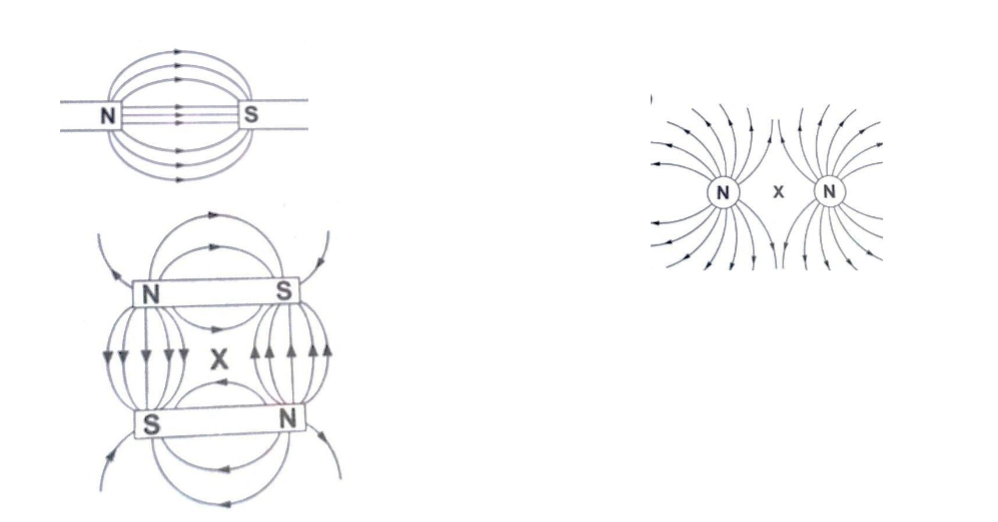
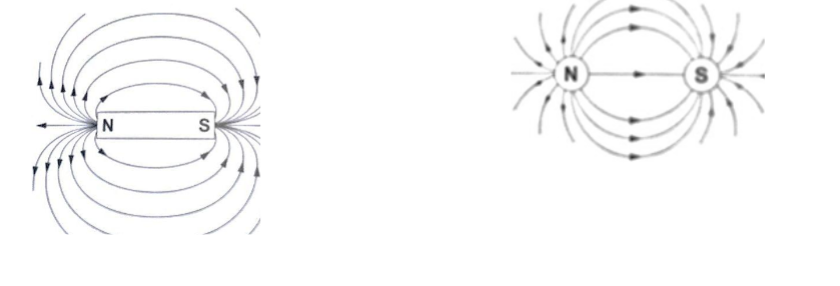
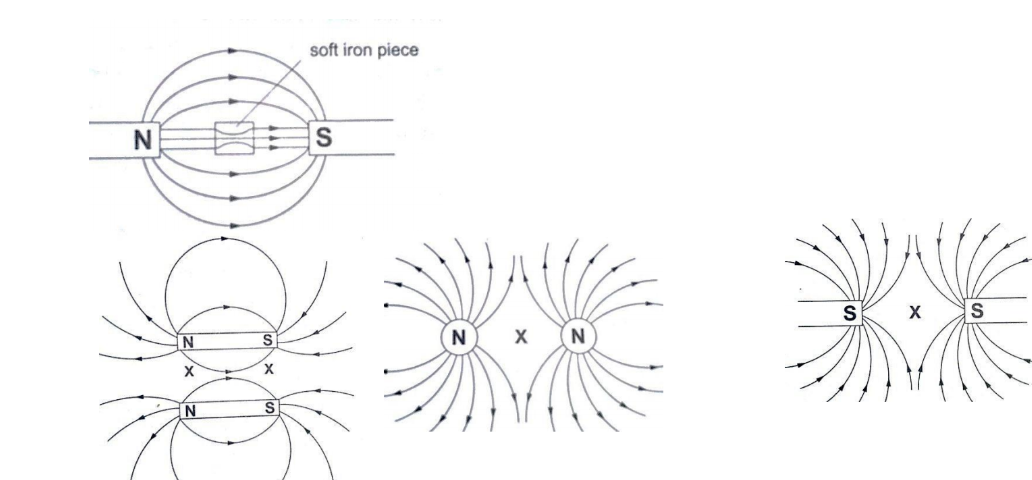
The points marked ‘X’ are called neutral points where there is no magnetic field at such points.
Watches (non-digital), electron beams in cathode ray tubes and TV sets are shielded from external magnetic fields by placing a soft-iron cylinder around the neck of the tube or watch.
Making magnets
The following are methods used to make magnets.
a) Magnetic induction – this is a process by which magnets are made by placing ferromagnetic materials in a magnetic field. Materials like iron lose their magnetism easily and are said to be soft while others like steel gain magnetism slowly but retain it longer and are therefore said to be hard and are used to make permanent magnets.
b) Magnetizing by stroking – the object to be magnetized is placed on a bench then a bar magnet is dragged along the length of the bar from one end to the other.
This is repeated several times and the object becomes magnetized. This method is known as single-stroke method.
c) Magnetizing using an electric current – this is the use of magnetic effect of an electric current through a solenoid (insulated wire of many turns).
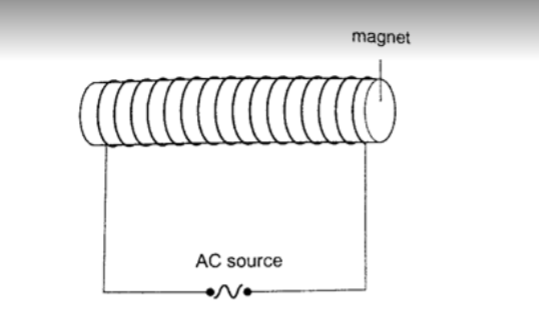
Demagnetizing
Demagnetizing is the process of removing magnetic properties of a magnet .
The following methods are which a magnet can lose its magnetism;
a) Hammering them hard with their poles facing E-W direction
b) Heating them strongly
c) Placing a magnet inside a solenoid and passing an a.c. current through it for a short time.
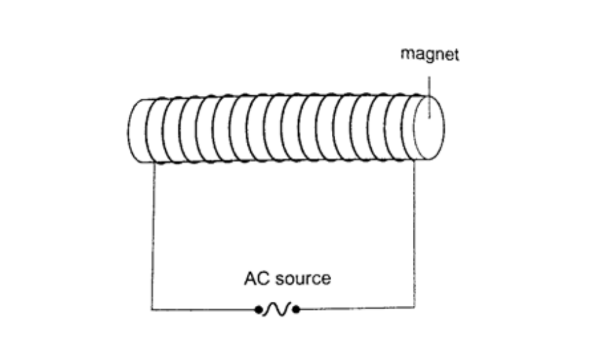
Caring for magnets
a) Magnets should be stored in pairs with unlike poles adjacent to each other attached to pieces of soft iron called keepers.
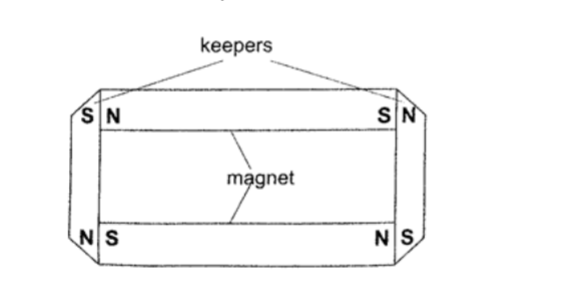
b) Magnets should not be hammered especially with their poles facing E-W direction.
c) Magnets should not be heated strongly or dropped roughly on hard surfaces.
d) Magnets should not be placed near alternating currents.
e) Magnets should be kept dry and clean since rust can make them lose their magnetism.
Uses of magnets
1. Used in making other magnets
2. Used in making loud speakers
3. Used in making moving coil meters
4. Used in making telephone speakers.
Domain theory of magnetism.
In ferromagnetic substances small atomic magnets form large groups called domains.
These atomic magnets face one direction where the direction varies from one domain to another.
In an un-magnetized crystal the directions of these domains are different hence their resultant magnetism is zero.

When a magnetic material is placed in a magnetic field the atomic magnets rotate and eventually all domains face the same direction.
When this happens then the material becomes magnetized.
When a material is magnetized we say it is saturated.
This means that the magnetism of the material cannot be increased by any other method and this is the domain theory of magnetism.
Chapter Two
Measurement II
Measuring length using vernier callipers.
Vernier callipers is used when higher accuracy in measurement is required and this cannot be done using a metre rule.
Vernier callipers has two scales; main scale and vernier scale. Outside jaws are used to measure both lengths and external diameters, inside jaws for measuring internal diameters while the tail is used for measuring depths of cavities .
The main scale is divided into cm and mm. The vernier scale is divided into 10 equal divisions of 0.9 mm each. The accuracy of vernier callipers is 0.10 mm.
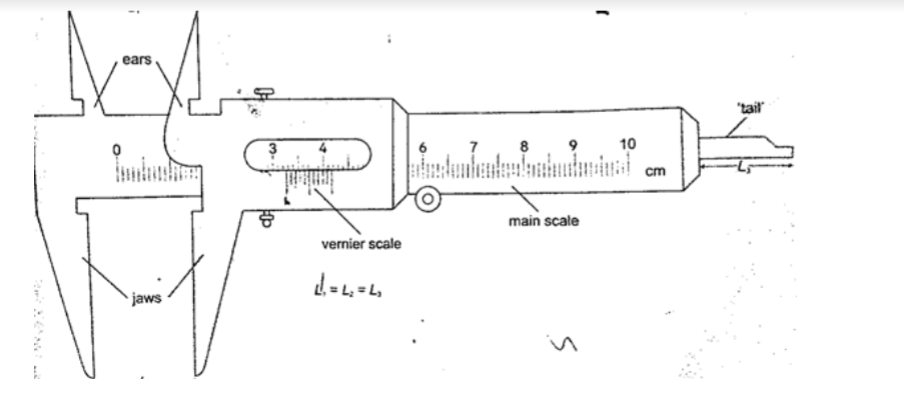
The reading is taken in two steps;
a) The main scale is read at zero mark of the vernier scale. The values given in cm.
b) The vernier is read at the position where a mark on the vernier scale is exactly lined up with a mark on the main scale. The values are given as a two decimal of a cm.
Examples
1. Give the reading in the following diagram.
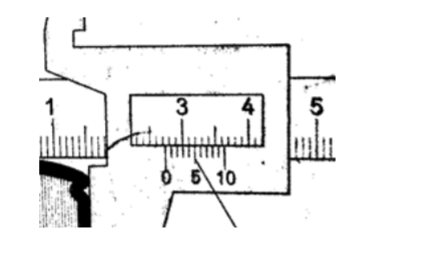
Solution
Main scale reading: – 2.7 cm
Vernier scale reading: – 0.04 cm
Adding both we get 2.74 cm.
2. What is the reading of the vernier callipers shown below?
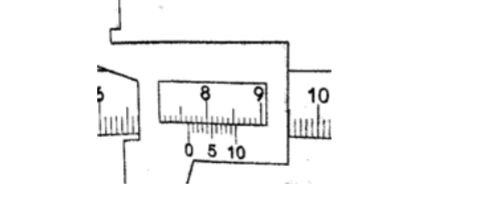
Solution
Main scale reading – 7.6 cm Vernier scale reading – 0.04 cm Adding both readings we get 7.64 cm.
Micrometer screw gauge
It is a device used to measure small lengths.
It has an accuracy of 0.01 mm. It has two scales; the sleeve scale and thimble scale.
The sleeve scale is divided into upper and lower scales with the upper division in mm and lower divisions in 0.5 mm.
Thimble scale is divided into 50 equal divisions each division consisting of 0.01 mm.
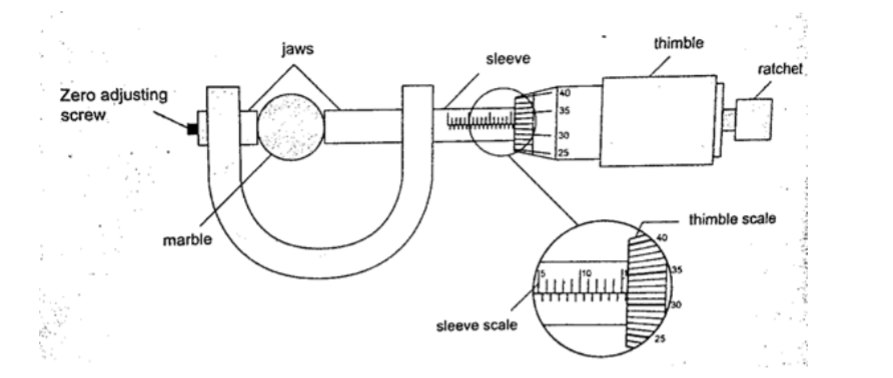
The reading is taken in two steps;
a) The reading on the sleeve scale is read ta the point where it touches the edge of the thimble in mm and half mm.
b) The thimble scale is read at the point where the centre line of the sleeve is parallel to the thimble scale division.
Examples
1. Give the reading in the following.
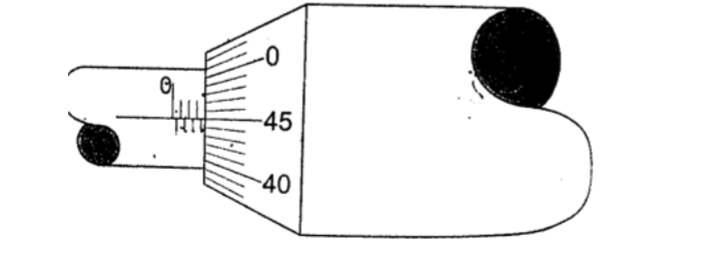
Solution Sleeve reading – 3.5 mm Thimble reading – 0.45 mm Adding up we get 3.95 mm.
2. What is the reading in the following micrometer screw gauge?
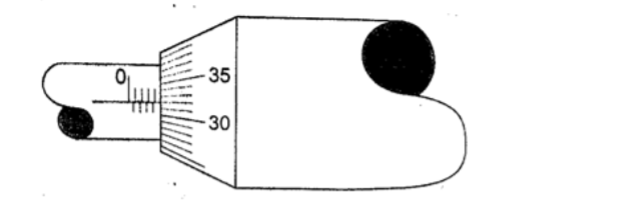
Solution
Sleeve scale reading – 4.0 mm Thimble scale reading – 0. 32 mm Adding up the two we get 4.32 mm.
Calculating the size of a molecule.
Both the volume and area of a drop can be calculated using the following formulas Volume = 4/3 πr3 and Area = πr2h.
Examples
1. A drop of olive oil, whose volume is 0.12 mm 3, was placed on a surface of clean water.
The oil spread and formed a patch of area 6.0 × 104 mm2. Estimate the size of the olive oil.
Solution
Volume = 0.12 mm2. Area of the oil patch = 6.0 × 104 mm2. Volume = area × thickness of the patch, therefore Thickness of the oil patch = volume / area = 0.12 / 6.0 × 104 = 2.0 × 10-6 mm or 2.0 × 10-9 m.
2. Suppose an oil drop has a volume of 0.10 mm 3 and forms a film with a radius of 10 cm.
Calculate, the thickness of the oil film. Solution
Area of the film = πr2 = 3.14 × 10 × 10 = 314 cm2 = 31,400 mm2.
Thickness of the oil film = volume / area, hence 0.10 / 31,400 = 3.0 × 10-6 mm.
(The thickness of the oil film is called upper limit to the size of molecule because the molecule cannot be bigger than the thickness of the oil film)
Chapter Three
Turning Effect of a Force
Turning effects
The turning effect of a body is called the moment of that force.
The turning effect produced depends on both the size of the force and the distance from the pivot.
The moment of a force about a point is the product of the force applied and the perpendicular distance from the pivot (or turning point) to the line of action of the force.
Hence, Moments of a force = Force × perpendicular distance from pivot.
The law of moments
The law of moments states that “when a body is in balance or in equilibrium, the sum of the clockwise moments equals the sum of anti-clockwise moments”.
The SI units of the moments of a force is Newton metre (Nm).
Examples
1. A uniform rod of negligible mass balances when a weight of 3 N is at A, weight of 3 N is at B and a weight of W is at C. What is the value of weight W?
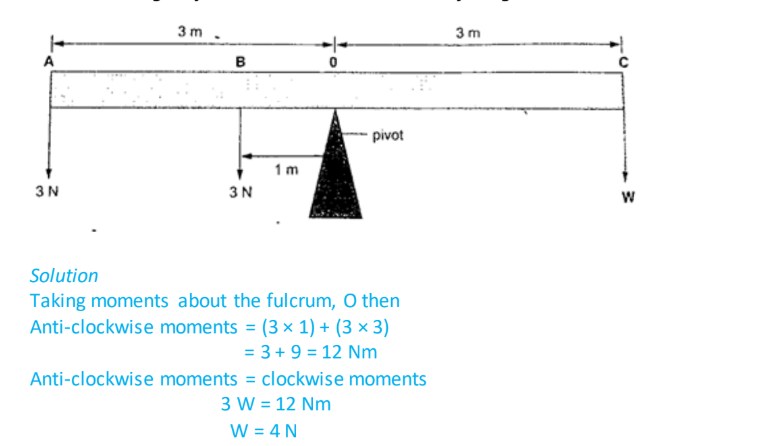
2. The following bar is of negligible weight. Determine the value of ‘ x’ if the bar is balanced.
Solution
The distance from the turning point to the line of action can be determined as,

Clockwise moments = 10 × 30 = 300 N cm, Anticlockwise moments = 10 × ‘x’ = 10 x. N cm. Using the principle of moments
Anti-clockwise moments = clockwise moments
10 x = 300, hence x = 30 cm.
3. Study the diagram below and determine the value of X and hence the length of the bar.

Solution
Clockwise moments = 15x N + 5(X × 20) N
Anticlockwise moments = (20 × 10) + (60 × 10) N cm, = 800 N cm.
Anti-clockwise moments = clockwise moments
800 N cm = 15X + 5X + 100
800 n cm = 20X + 100
20X = 700
X = 35 cm.
Therefore, the length of the bar = 40 + 20 + 35 + 20 = 115 cm.
The lever
A lever is any device which can turn about a pivot or fulcrum .
The applied force is called the effort and is used to overcome the resisting force called the load. We use the law of moments in the operation of levers.
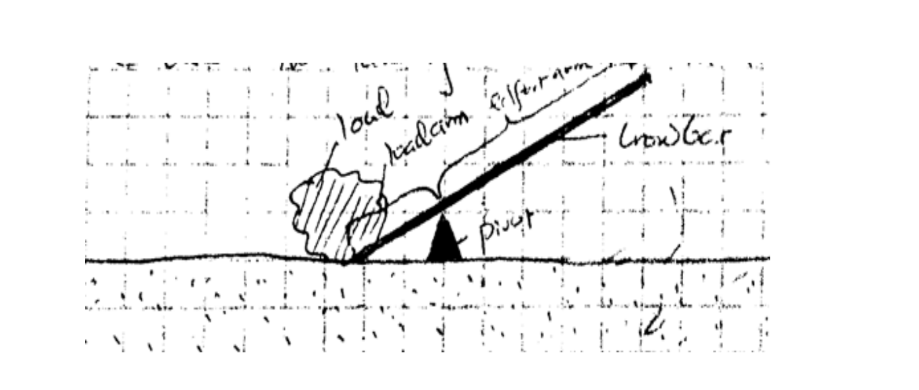
Example
Consider the following diagram. (The bar is of negligible mass). Determine the effort applied.
Solution
Taking moments about O. Then, clockwise moments = effort × 200 cm. Anticlockwise moments = 200 × 30 cm.
Effort = (200 × 30)/ 200 = 30 N.
Chapter Four
Equilibrium and Centre of Gravity.
Centre of gravity
Centre of gravity or C.G is the point of balance of a body in which the total weight of the body seems to act through.
For regular shaped bodies the C.G is at the geometric centre of the body. For irregular bodies their weight still acts at the centre of the gravity and the law of moments can be used to determine the weight of the body.
2024 FORM 1 2 3 4 REVISION RESOURCES
FORM 1 2 3 4 TERM 1 2 3 OPENER , MID AND END TERM EXAMS
1995-2024 KCSE KNEC PAPERS QUESTIONS,ANSWERS AND REPORT
2008-2024 KCSE FORM 4 COUNTY MOCKS
FORM 1 2 3 4 SCHEMES OF WORK
FORM 1 2 3 4 LESSON PLANS
FORM 1 2 3 4 CLASS REVISION NOTES
FORM 1 2 3 4 TERM 1 2 3 HOLIDAY ASSISNMENTS
FORM 3 4 SETBOOKS STUDY GUIDES
FORM 1 2 3 4 TOPICAL TESTS
FORM 1 2 3 4 REVISION BOOKLETS
LIFE SKILLS NOTES
FORM 1 2 3 4 SYLLABUS
KENYA SCHOOL CODES
HOW TO REVISE AND PASS EXAMS
GUIDANCE AND CONSELLING NOTES
CLICK HERE TO DOWNLOAD ALL LATEST 2024 KCSE REVISION MOCKS
KCSE COUNTY MOCKS DOWNLOADS 2024
2023 KCSE COUNTY MOCKS DOWNLOADS
- 2023 KAPSABET BOYS POST MOCK
- PANGANI MOCK KCSE 2023
- KCSE 2023 LAINAKU II FORM 4 JOINT MOCK
- KENYA HIGH POST MOCK
- KALA MOCK =Password is- subjectcodeKALA2023
- KCSE 2023 SAMIA JOINT MOCK
LANJET 2023 EVALUATION MOCK
2023 EVALUATION MOCK nyandarua trial 4
2023 EVALUATION MOCK nyandarua trial 3
KCSE 2023 MOCKS NYARIRA CLUSTER EXAMS
KCSE 2023 CEKANA MOCKS
KCSE 2023 ACHIEVERS JOINT MOCK
- KAPSABET 2 MOCK 2023
- MOKASA 2 MOCK 2023
- 2023 Mang’u high revision mock
- FORM 4 TERM 2 BAKALE EXAM
CATHOLIC DIOCESE OF KAKAMEGA MOCK
- BSJE JOINT MOCK EXAM 2023
- MARANDA HIGH SCHOOL MOCK JUNE
- KCSE 2023 mock Nginda girls
- 2023 Kcse mock Wahundura
- 2023 Kcse mock set 22
KCSE 2023 KASSU MOCK EXAMS
- 2023 KCSE EAGLE TRIAL 1 MOCK
- 2023 lainaku revision mock
- 2023 FORM 4 evaluation exams set 18
- 2023 FORM 4 evaluation exams set 17
- 2023 FORM 4 evaluation exams set 16
LUGARI CONSTITUENCY -MOCK 1
- 2023 KCSE FORM 4 EVALUATION TEST
2023 mokasa mocks revision exams
- SUKELLEMO JOINT PRE-MOCK EXAMS
- Mumias west pre mock kcse exams
- 2023 SUNRISE PRE-MOCK
- 2023 kcse arise and shine pre-mock
- MECS CLUSTER JOINT MOCK EXAM
- Chogoria murugi zone pre-mock
- MOMALICHE 2 EXAMS PRE MOCK
- ASUMBI PRE MOCK EXAMS 2023
- 2023 MARANDA HIGH PRE-MOCK
- KAPSABET INTERNAL TRIAL 1 2023
- FORM 4 EVALUATION TEST 2023
- 2023 FORM 4 evaluation exams
Mock exams and pre-mock exams are practice tests that are taken before the actual exams.
2022 COUNTY MOCKS 38 EXAMS
2021-22 COUNTY MOCKS 36 EXAMS
2020-21 COUNTY MOCKS 24 EXAMS
2019 COUNTY MOCKS 44 EXAMS
2018 COUNTY MOCKS 23 COUNTIES EXAMS
2017 COUNTY MOCKS 25 COUNTIES EXAMS
2016 COUNTY MOCKS 16 COUNTIES
2015 COUNTY MOCKS 20 COUNTIES
2008 , 2009 , 2010 , 2011 , 2012 , 2013, 2014 COUNTY MOCKS 25 COUNTIES
2023 KCSE COUNTY MOCKS Mock exams and pre-mock exams are practice tests that are taken before the actual exams.
They are designed to help students get a sense of what to expect in the real exam and to identify areas where they need to improve.
The purpose of taking mock exams is to help students build confidence, develop test-taking strategies, and identify their strengths and weaknesses.
Pre-mock exams are usually taken a few weeks or months before the actual exam, while mock exams are usually taken closer to the exam date.
 WhatsApp us Now
WhatsApp us Now